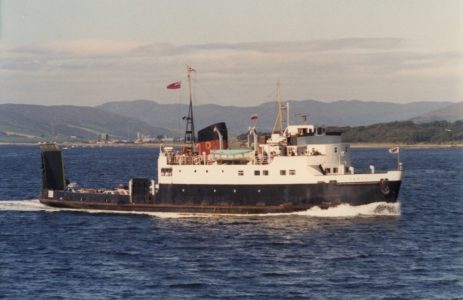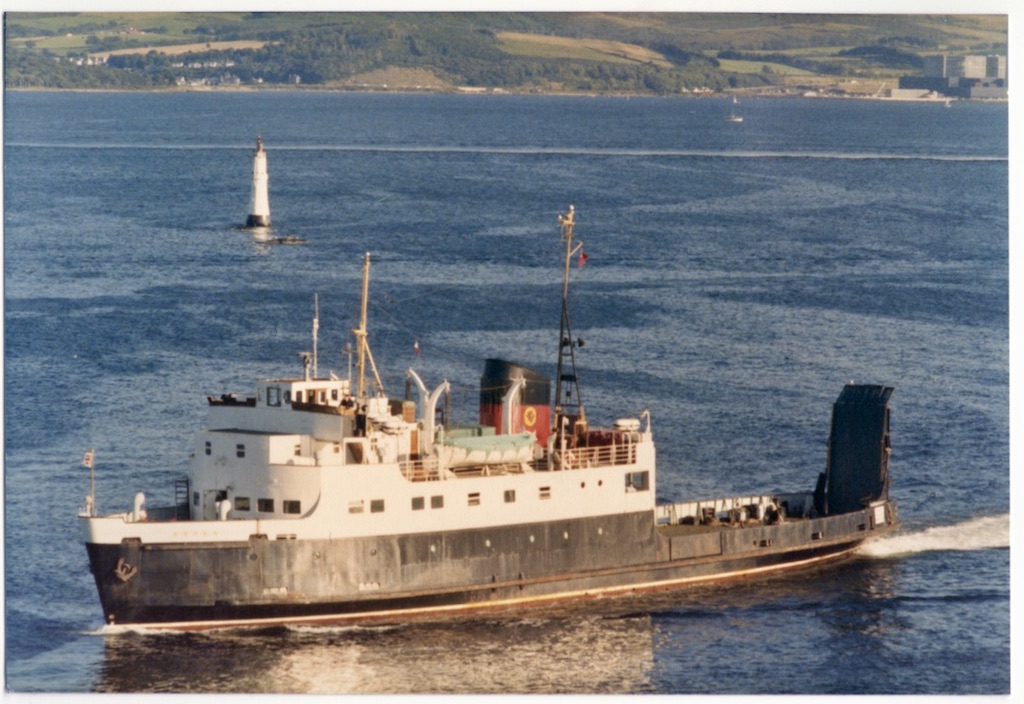
Arran approaches Dunoon on 26 August 1978: despite being ‘truly disfigured’ by her 1973 conversion to end-loading, she still makes a fine sight. Copyright Lawrence Macduff
It is 40 years since Lawrence Macduff climbed Castle Hill at Dunoon to photograph Glen Sannox, Queen of Scots and Arran on Cowal Games day. In this latest chapter of his ‘Confessions of a cameraman’, Lawrence has his memory jogged by the pictures he took on that busy Saturday.
It is 26 August 1978 and, as always on Cowal Games day, large numbers of people have to be shifted in and out of Dunoon. This places great strain on the passenger capacity of whatever ferries are on duty, so other members of the CalMac fleet, whether or not suited to carrying large passenger loads, invariably have to be drafted in to help.
Unusually for Cowal Games, the weather was fine all day. I started with a trip to Rothesay on the nearly new Saturn. Her running mate that day was the anything-but-new Arran — disfigured since 1973 when she had been converted to end-loading for the Islay service. Since 1975 she had been deployed mostly out of Oban, but even this ugly duckling, on one of her infrequent return visits to the Clyde, had to be captured by any madasafish camera wielder in the vicinity.
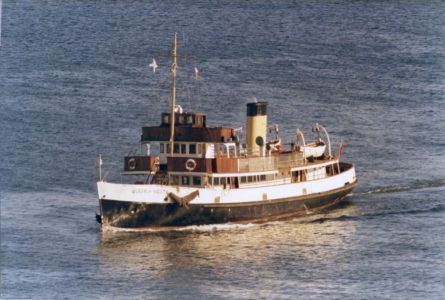
Scene from Castle Hill: Queen of Scots basks in the sunlight off Dunoon on 26 August 1978. Copyright Lawrence Macduff
From the deck of another ship, a picture of a passing ferry is not really a big deal, is it? For a start there’s no physical exertion, so in comparison to my usual frenetic activities, I hardly knew what to do with myself. Ah, but there’s always a sense of anticipation in the pursuit of that elusive picture.
First step is to check to which side your quarry is likely to pass. It’s invariably port side to port side – I can now see Arran coming out of Rothesay Bay — so yep, that looks as it should be. OK, where’s the sun ? Will the ship be cross-lit as she passes? That can be good for contrast, as well as for hiding all the rust streaks on the hull. Or will she be sunlit from stem to stern, which will show up every last wart on her paintwork?
Now, what about the background your target will be set against? Is there anything ashore that will identify the location – maybe a castle or a buoy or even a lighthouse? Well, yes, with a bit of luck I’ll maybe get Toward Lighthouse in this picture. And where is the best place to take this picture from? There’s a bit of a sou’westerly breeze today, Saturn is making 13 knots and I’m shooting into a fair draught. I could do with some protection, though I actually don’t see much shelter.
Here’s a stanchion that might help steady the camera. With that big telephoto lens attached, it’s a cumbersome brute and needs supported. Arrrgh … that‘s nae use …. vibration coming up through the deck, enough to ruin the picture. I’ll have to do without it.
The ship is getting nearer – my Galaxy 300mm is on my Praktica camera as my 135mm lens won’t get near the ship — and remember folks, this is 1978 so no zoom lenses and no camera anti-shake technology either. And what about the exposure meter? Help! Ah nearly furgoat that!
I’m now focused on Arran. Ardyne Point is behind her and – bingo – I’ve bagged her, including all the unwanted site hardware behind the ship. But I was never going to be able to spin the big lens off and fit up the 135mm in time – not with the 26-knot passing speed of the two ships and anyway, in my excitement, my toe has caught the small lens and propelled it into the scupper. At least that was dry and the lens is undamaged. Mission accomplished – sort of.
Now here’s a thing. The late Jim Aikman Smith — and don’t ask me how he did it because everything was a blur when he was in action — managed to operate a colour negative camera and a colour slide camera almost simultaneously. Everything was slung around his neck, in a mass of cords, straps, time-release and flashgun cords, yet he still did the biz and his pictures are testimony to that.
Like me, Jim’s principal film medium was colour prints, but he also took slides for other enthusiasts and I used to hear him mutter irascibly at times that this was a job for mugs! I tried to emulate him using both print and slide cameras, but never had the same knack.
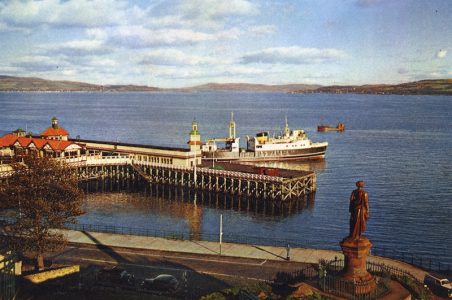
When life was young: a picture postcard view of Arran (or one of her ABC sisters) leaving Dunoon c1955, with Highland Mary surveying the scene from Castle Hill
Excitement over, it’s time to high-tail it to Dunoon. At the ripe old age of 32 I’ve still not not bought my first car, so it’s the Blue Train (remember them?) from Wemyss Bay to Greenock Central, and change there for Gourock.
Here’s Glen Sannox at the berth, a bit less busy now as everyone is already in Dunoon. I enjoy the sail across, then immediately high-tail it to the top of Castle Hill where everything coming in and out of Dunoon is a sitting duckling, ugly or otherwise.
The ‘Sannox’, re-juvenated last year with a new pair of engines, has been deployed to move the crowds as she is now the biggest passenger carrier in the fleet.
Then a really nice surprise appears on the horizon. The little Queen of Scots (formerly Caronia) is arriving from Rothesay.
Queen of Scots was working till recently for Sir Robert McAlpine, servicing the oil rig fabrication site at Ardyne. When that work petered out, the wee ship became redundant until she was needed at the height of the 1977 summer to rescue the tail end of Waverley’s Clyde excursion programme, following the paddler’s Gantocks disaster. Today, Cowal Games Saturday, she is running three Rothesay-Dunoon returns under the flag of BB Shipping.
One thing about Castle Hill is that, once the effort of the ascent (on concrete steps, no less) is complete, no further physical exertion is necessary. Not only did the little ‘Queen’ make a nice picture, so did Arran, which was later despatched from Wemyss Bay to assist in moving the returning hordes at the end of Games day. This was certainly one of my least exhausting missions around that time, but at 30-something I was still fit for plenty more breath-extracting missions.
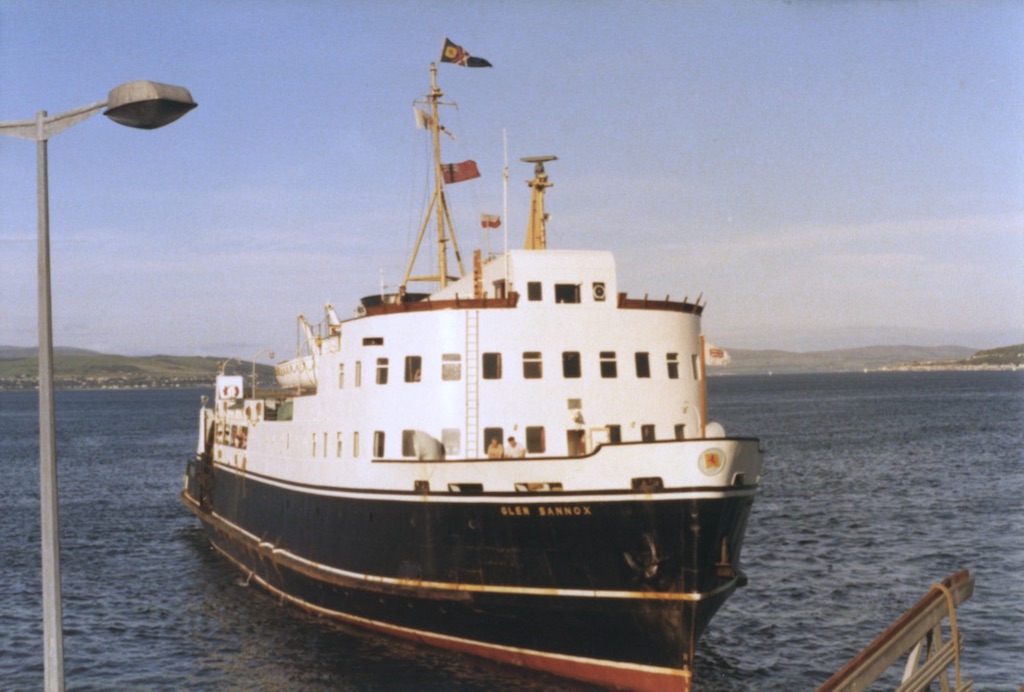
The biggest passenger carrier in the fleet: Glen Sannox at Dunoon on Cowal Games day 1978. Copyright Lawrence Macduff
Not yet a member of CRSC? Join here for only £10. Paid-up members receive CRSC’s 56-page colour magazine and the comprehensive annual Review of west coast shipping, plus discounts on special sailings, photos and DVDs — and a winter session of talks by shipping experts in Glasgow.
Published on 25 August 2018












